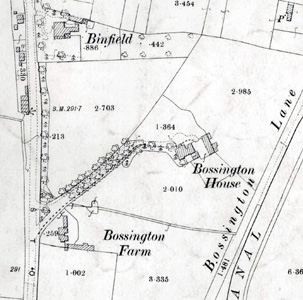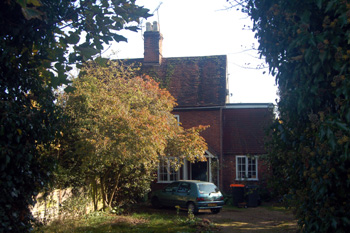
Bossington House and Farm in 1901
Bedfordshire & Luton Archives & Records Service has some material on this area of Linslade in the 19th century. In 1822 Leighton Buzzard solicitor David Lee Willis, acting as agent for the Lord of the Manor of Linslade, Sir Andrew Corbet leased three closes called Middle Close, Gravel Close and Gravel Pit Close containing 19 acres, 3 roods, 26 perches and part of Bossington Farm to Leighton Buzzard publican Coleman Ginger [licensee of the Bell, now called the Top Bell in the Market Square] for £60 per annum [BO675].
Two years later David Lee and Jeremy Willis purchased Bossington Farm from Sir Andrew and made an arrangement with Sir Andrew's mortgagee, Thomas Lane Wood of Leighton Buzzard. Some of the mortgage had been redeemed and the Willises agreed to place it "out at interest", that is, to lend it in another mortgage on land in Thornborough [Buckinghamshire] on Wood's behalf [BO676-677] whilst leaving the securing the unredeemed portion of the loan on the farm [BO678-679].

Site of Bossington House October 2008
It seems as if, between 1824 and 1889 a member of the Willis family built a large house on part of the Bossington farm land. On 13th August 1889 the house and over 53 acres of land was put up for sale by auction at the Swan Hotel in Leighton Buzzard High Street by Frederick and David Thomas Willis [BML10/44/25]. The sale particulars described the house, Lot 1, as follows: "All that very desirable modern and compact freehold family residence situate at Linslade, Bucks, approached by a Private Road leading from the High Road from Leighton Buzzard to Bletchley, also by the Private Occupation Road known as Bossington Lane, and now in occupation of E.C.Peake, Esquire".
"It contains on the Ground Floor, Entrance Hall, Dining Room 18 feet by 16 feet, Drawing Room 17 feet by 16 feet, Morning Room, Lavatory, w.c., capital Kitchen, Scullery and Domestic Offices. On the First Floor Four Bed-rooms, Dressing Room, Bath Room, Lavatory and w.c. On the Second Floor, Three Bed-rooms, Box-room etc., and good Cellarage in Basement. The Stabling comprises Three good Loose Boxes, Washing Box, Coachhouse, with Loft, Harness Room and Groom's Room".
"The House is beautifully situated upon a dry, sandy subsoil, with capital spring water supply and perfect sanitary arrangements, standing in its own grounds, consisting of tastefully laid out Garden and a Close of Capital Old Pasture, the whole covering an area of 5 acres, 2 roods, 10 perches or thereabouts". The house was sold to William Page for £2,450".
Lot 2 comprised 15 acres, 3 roods 17 perches of arable land and Lot 3 8 acres, 3 roods, 15 perches of pasture land. These sold for £1,450 and £950 respectively. Lot 4, 28 acres, 3 roods, 22 perches of pasture land was withdrawn.

38 and 40 Stoke Road October 2008
At some point during the 20th century Bossington House and most of Bossington Farm was demolished. The carriage road survives as Lime Grove - the site of the house being at the north-easternmost end. Part of the farm buildings survives as 38 and 40 Stoke Road. The building was listed by the former Department of Environment as Grade II, of special interest. The building is 18th century and made of red brick with an old tile roof.
Directories reveal the following occupiers of Bossington House: